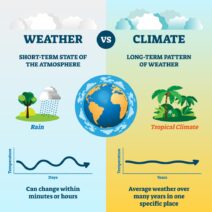Understanding the profound interplay between ocean currents and global climate is imperative for grasping the complexities of our planet’s climate system. Ocean currents, the vast streams of water that circulate through the world’s oceans, are driven by wind, water density differences, and the Earth’s rotation. They profoundly influence weather patterns, heat distribution, and the overall climate of various regions. This article delves into the intricate ways in which ocean currents affect global climate, exploring their mechanisms, effects, and the concomitant implications for our environment.
Ocean Currents: The Lifeblood of Climate Regulation
To appreciate the fundamental role of ocean currents, one must first understand their basic characteristics and types. Ocean currents can be broadly classified into two categories: surface currents and deep-water currents. Surface currents, primarily driven by wind, affect the upper 400 meters of the ocean. They can travel vast distances, influenced by major wind patterns and the Earth’s rotation through a phenomenon called the Coriolis effect.
In contrast, deep-water currents, part of the global conveyor belt system, are driven by differences in water density, which is affected by temperature and salinity. These deep currents move slowly but encompass a significant volume of water, acting as a crucial mechanism for the redistribution of heat across the globe. The interplay of these two types of currents—surface and deep—forms an intricate web that significantly regulates climate.
The Role of Currents in Climate Zones
The effects of ocean currents on climate are most palpable in the delineation of climate zones. Warm currents, such as the Gulf Stream, transport heat from equatorial regions towards the poles, significantly moderating the climate of coastal areas. For instance, the Gulf Stream contributes to the relatively mild winters of western Europe, notwithstanding its high latitude. Conversely, cold currents, such as the California Current, can have cooling effects on coastal regions and are instrumental in creating arid conditions in adjacent land areas.
These currents not only affect temperatures but also play a critical role in precipitation patterns. Regions influenced by warm currents typically experience increased evaporation, leading to higher humidity levels and, consequently, more precipitation. Conversely, regions influenced by cold currents often encounter reduced evaporation and lower precipitation, contributing to desertification in some cases. The interplay between ocean currents and resultant climate zones reveals the essential nature of these currents as climate regulators.
The Influence on Weather Patterns
Ocean currents significantly shape weather patterns through their interplay with atmospheric conditions. When warm water currents warm the air above them, they lead to the formation of weather phenomena such as cyclones and hurricanes. The correlation between sea surface temperature and hurricane intensity is a prime example, where warmer waters can intensify storm systems, leading to more catastrophic weather events.
Moreover, phenomena like El Niño and La Niña illustrate the power of ocean currents in dictating weather conditions across the globe. El Niño, characterized by the warming of surface waters in the central and eastern Pacific, leads to widespread alterations in weather patterns, including increased rainfall in some areas and droughts in others. Conversely, La Niña, the cooling counterpart, tends to create its own set of climatic anomalies, demonstrating the cyclical nature of oceanic influences on weather.
Climate Change and Ocean Currents
As climate change continues to shape our world, the role of ocean currents is becoming increasingly crucial to monitor and understand. The alteration of ocean temperatures due to global warming is already affecting current patterns, which can disrupt the delicate balance maintained over millennia. For instance, the weakening of the Atlantic Meridional Overturning Circulation (AMOC), a vital component of the global conveyor belt, could lead to profound shifts in climate, including increased sea level rise along the US Eastern seaboard and altered weather patterns in Europe.
The absorption of carbon dioxide by oceans also complicates the dynamics of ocean currents. Increased CO2 levels lead to ocean acidification, impacting marine ecosystems and the biodiversity that forms the backbone of global fisheries. This disruption can have cascading effects on food security, economies, and social stability, highlighting the critical intersection between ocean currents, climate, and human resiliency.
Future Implications of Ocean Currents on Global Climate
As we delve into the future, the resilience of ocean currents and their ability to adapt to changing conditions will be vital to mitigate the effects of climate change. As they continue to influence global climate patterns, research into oceanic systems, thermal dynamics, and chemistry will be paramount. Enhanced monitoring technologies and predictive models can provide insights into these complex interactions, informing policy decisions and adaptive measures.
In conclusion, ocean currents are integral to the global climate system. Their effects on temperature regulation, precipitation patterns, and weather phenomena are profound and far-reaching. As climate change continues to unfold, understanding and safeguarding these vital currents will be essential to maintaining climate stability and ensuring a sustainable future for all living ecosystems on Earth.






